| |
|
 |
|
Deep within the soil of
Suffolk, the germ of memory sleeps.
Generations forget; their history is
effaced, and they are left oblivious,
aware only of their surroundings. They no
longer ask how they got here. And then,
the soil is turned, the plough cleaves
the furrow, and the past is revealed. And
sometimes memory sleeps on the surface;
we do not even know that we have
forgotten.
Between about 1530 and 1570, England
underwent a cultural revolution, a
process as violent and traumatic as
anything that has happened in our
history. In less than half a century,
England went from being a complex and
clumsy melange of largely self-governing
Catholic communities which looked to Rome
as much as they did to London, to being
an insular and centralised Protestant
nation where power was maintained by the
sword.
The process was not complete. The
pendulum continued to swing, and by the
mid 17th century England had become a
theocracy, with political policy based on
an explosive mixture of Biblical
fundamentalism and a misguided sense of
destiny. At Drogheda, Cromwell's troops
would dutifully slaughter the women and
children of the town, safe in the
knowledge that they were doing God's
work. Of course, the evil they were
rooting out was the very religion that
their forefathers had shared, for
generations.
|
Suffolk retains one of the most
powerful testimonies to the glory of that former
age, and to the violence of its destruction. And
yet, for generations it was almost completely
forgotten.
Fifteen years have passed. It was Saturday,
September 9th, 2000. I stood in the ruins of the
great abbey of St Edmundsbury, writing the words
I am editing now. I was in what was probably the
scriptorium, where generations of monks copied
texts borrowed from other monasteries, or came
here to copy the monastery's own, building up the
great libraries of the Middle Ages. They worked
on the Gospels, and other books of the Bible.
They copied the works of the spiritual fathers,
and the classical histories.
The task was laborious, but was an act of prayer
and contemplation in itself. Even making the
materials became a meditation; the ink was
prepared in a base of egg white and honey; the
bright colours of the illustrations came from
crushing precious stones.
The atoms of silicon in those stones were
identical to the ones in the microchips inside
the laptop i was using that day. They converted
my words into a pure digital stream, which moved
at the speed of light as I uploaded it onto the
Suffolk Churches website, still in its infancy
then. The computers belonging to the users of the
site contained more of these silicon atoms, these
precious stones. They downloaded and reconverted
my digital stream into a language that was the
bastard son of the Latin in which the monks
wrote, the vulgar tongue of the townspeople
beyond the walls, and the Norman French of their
new masters.
I wandered through the chapter house, and into
the great north transept of the Abbey church
itself. The monks in the scriptorium made the
same journey, whenever the bells rang for the
daily offices. Now, I stood inside one of the
largest Romanesque churches in Europe. In my
mind, I lived and relived what it would have been
like to be here then.
Sometimes books aren't enough, and sometimes they
tell us what we'd really rather not know. Any
decent local history will tell you about the
glories of Bury Abbey, about its run-ins with the
local people, the riots and the riches, of how it
lived and died. Now, this is all very well, but
more interesting I think is the possibility of
sensing what it was like to live here as an
ordinary monk in, say, the 13th century.
Fortunately, the daily life of Bury Abbey is one
of the best documented of all lost medieval
communities. In the scriptorium that I had just
left, a monk called Jocelin of Brakelond wrote a
chronicle of this Abbey and its times; it is
effectively the story of the adolescence of the
county of Suffolk. A difficult time, with
troubles still to come.
For most people, there are two big surprises
about the ruins of the Abbey. Firstly, how
extensive they are, and secondly how tamed and
domesticated they appear in the large and
pleasant Abbey Gardens, in this most pleasant of
all East Anglian towns. The outer Abbey wall,
which housed and contained the Abbey
outbuildings, still survives to a greater extent,
forming the boundary of the park, and with some
very nice 18th and 19th century houses built into
it since.Two of the conventual churches, St James
(now the Anglican cathedral) and St Mary, survive
pretty well intact, along with a wall and charnel
house of a third, St Margaret. So do two of the
gateways; one is still the main entrance to the
park, and the other is considered one of the
finest survivals in England, temporarily houses
the Anglican cathedral bells.
But it is the ruins of the great Abbey church of
St Edmund that astound. A vast, cruciform
building, it was more than 500 feet long and 200
feet wide. You could fit Suffolk's biggest parish
church, St Peter and St Paul at Lavenham, into
the nave and transepts four times, and still have
room for Thornham Parva up in the sanctuary. It
is possible to trace the structure almost in
entirety, apart from the south aisle and west
front, which have been swallowed up by later
buildings.
And the setting! At the end of the apse are
municipal tennis courts, with an incongruous
bowling green tucked in beside the north
transept. A children's playground, a rose garden,
a museum (the 'St Edmundsbury Experience') all
surround it. You would be harsh to hate it, I
think, because it gives the people of the town a
sense of ownership; for these ruins are wholly
accessible at all times the park is open, and,
miracle upon miracle, entrance is completely
free.
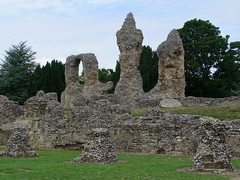  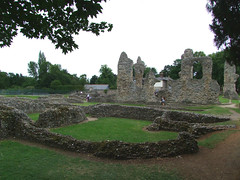 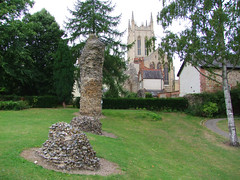
So, how did this extraordinary
building come to be here? How is it that one of
the great churches of Europe was destroyed?
The story starts some 30 miles east of here, in
the village of Rendlesham, near Woodbridge.
Unlikely as it may seem, this was almost
certainly the capital of the Anglo-Saxon Kingdom
of East Anglia. Today, despite being relatively
suburban, and on the edge of a large former
American airbase, there is still a haunting sense
of the remote past, enhanced by the forests that
ride the ridges of the heathland. Here lived the
Wuffingas, the Saxon royal family. Most prominent
among them was Redwald, King from 599 to 625. A
pragmatic man, he established his kingdom as one
of the primary trading areas of north west
Europe. In the Gipping valley, his quays,
workshops and settlements coagulated into
Gyppeswick, the modern Ipswich. By the 8th
century, it was the largest town we know of in
northern Europe.
We should not be surprised that his capital and
trading port were in the south east extremity of
his kingdom, any more than we should be surprised
that London, England's capital today, is also in
the south east. For Redwald was a European, a
federalist rather than an empire builder. For
him, it was trade rather than conquest that built
up his fabulous wealth. In an essential act of
embracing the European sphere, Redwald became a
Christian; but it was said that in his palace at
Rendlesham he kept two altars, one for the
Christian God he had adopted, and one for the
pagan gods of his forefathers, for he was a
pragmatist to the last.
And, at the last, his body was taken slowly in
procession from the Christian church at
Rendlesham, across the heathlands, until on
Sutton Hoo it was met by a huge ship which had
been dragged up from the Deben estuary below.
There, he was buried in it, along with weapons,
clothes, armour, musical instruments, jewellery,
symbols of sovereignty; the signs of his majesty
and trading might. His son, Sigebert, carried the
Christian torch after his death. And now,
Chritianity became a way for the Wuffingas to
reinforce their sovereignty.
Sigebert invited representatives of the Church
into his kingdom. From Burgundy came St Felix, a
beacon of Roman orthodoxy.From the monasteries of
the north came St Fursey, steeped in Celtic
spirituality. Later, from Germany, came St
Botolph, architect of monasticism. From his
cathedral at Dumnoc, the modern Walton, Felix
directed the consecration of Minsters in the
trading communities of the Kingdom. Sigebert also
turned to the monastic life. He set off
westwards, towards the limits of his kingdom, and
at a place called Bedricsworth established a
community of like-minded souls, the rest of their
lives devoted to prayer and contemplation.
Which might easily have been the end of the
story, of course; Bedricsworth was just one of
many Christian communities of the time. Some have
disappeared into oblivion, and it might have been
one of these. But there are others where the germ
of memory has thrived, and taken root. One of
these was a place called Lindisfarne, some 300
miles to the north. There, a similar community
were going about their morning round of prayer
and farmwork in the summer of the year 793, when
a group of long, low boats were sighted on the
eastern horizon. The boats landed on the shore
below the monastery, a place that is still a
harbour today. The sailors climbed to the
monastery, and sacked it. They killed most of the
monks, stole the produce of the farm and the
furnishings of the church, and burned the
monastery down. And then they left, returning to
where they had come from.
It was the Vikings, of course. Over the next
fifty years, the attacks of these Danish hordes
increased along the entire eastern seaboard, both
in number and ferocity. The Kingdom of East
Anglia was wide open to their depredations.
Gippeswyck was obvious game, the richest trading
port in the land. The Saxons, mainly farmers,
craftsmen and small traders, were powerless. What
the Kingdom needed was a hero.
His name was Edmund. From his headquarters at
Rendlesham, he set out to drive the heathen
invader from the land. A king leading his troops
into battle, he became more than a figurehead. He
was an icon. And then, in 869, in a parish called
Hellesdun, which was probably the modern Hoxne
but may have been Bradfield St George, he was
captured by Danish troops. In front of the
assembled Saxon prisoners, he was mercilessly
butchered, Danish troops firing hundreds of
arrows into his body at close range.
Who can separate legend from fact at such a
distance? The story is that the corpse was
decapitated, the head being thrown into a
thicket. Saxon soldiers dispersed in the battle
slowly returned, to find the headless body of
their king. They searched for three days, and
eventually came upon a giant wolf, guarding the
head of Edmund between its paws. The body was
taken to an unknown place called Sutton, which
may have been Sutton Hoo, or possibly Sutton in
the parish of Bradfield St George, or perhaps
somewhere else. Within a generation,
hagiographies were being written, Edmund's
sainthood secure.
The cult grew. Some fifty years after the
martyrdom, the remains were translated to the
Abbey at Bedricsworth; it became a major centre
of pilgrimage, as people came from all over to
seek the favours of the martyr king, the symbol
of resistance to the Danes. Within the century,
it is being called by its new name, the name it
has today, Burgh, or Bury, St Edmunds.
A few years later, came a crisis; the monastery
was no longer judged a safe place for the bones
to lie, either because of the Danish war, or more
likely the inefficiency of the community. It was
translated to London in 1010, where it lay in St
Paul's churchyard. In 1013 it was returned to
Bury, but only on the condition that the
community was replaced with one that followed the
rule of St Benedict. Secular priests had proved
unreliable.
The magnitude of Edmund's cult can best be judged
by the fact that at Domesday in 1086, the
monastery had 300 separate holdings of land
throughout the east of England. About 70 of them
were in the western part of Suffolk, including
Long Melford and Mildenhall, and almost the
entire area to the north and east of the
monastery itself, as far as the Norfolk border.
The Abbey had complete legal jurisdiction over
the eight Hundreds of West Suffolk, which was
known as the Liberty of St Edmund, and roughly
corresponded to the West Suffolk County Council
area which survived until 1974.
The Abbey church was rebuilt about this time, the
tomb of St Edmund being erected in 1095. The body
was translated into it with great ceremony, along
with the bodies of St Jurmin, brother of St
Etheldreda and son of King Anna of Blythburgh,
and what Norman Scarfe wittily calls 'at least
part of St Botolph'. It took another 100 years
before the rest of the building was finished. The
town around was built up, with the construction
of a grid of streets and hundreds of houses. It
was a medieval new town.
The monastery reached the apex of its power in
the late 12th century under the charismatic Abbot
Samson, familiar to East Anglians as a symbol of
the Greene King brewery. By now, there were about
a hundred monks and secular priests in residence,
and as many again of workers and servants.
Parliaments met here, monarchs arrived with their
retinues. History was made. The library became
one of the intellectual centres of Europe, with
more than 2,000 volumes. Visitors to the Abbey
describe it in the terms one would use of a great
city. It was the glory around which Suffolk
gathered and spread, the pulsing heart of all
power and spirituality.
Fortunately, it is still possible for us to see
what the Abbey church of St Edmund was like. We
can do so by travelling 30 miles to the north
west, to the tiny beautiful city of Ely in
Cambridgeshire. There, we find a Cathedral of
roughly the same proportion, configuration and
style. Replace Ely's famous lantern tower with a
spire, and the illusion is complete. The south
west tower of Ely survives (that to the north
west fell in the 17th century) and we can see the
same south west tower at Bury, surviving as part
of the building overlooking the square between St
James and St Mary. Here is a good place to start.
Beyond and beside are modern buildings, so to
explore the rest of the Abbey church ruins we
must go through the gate to the north-east of St
James - or, if this is locked, as it sometimes
is, back out on to Angel Hill, and into the park
through the Abbey gateway.
The best approach to the ruins is then found by
bearing right, up past the bowling green, and
into the conventual buildings beside the north
transept. These include the scriptorium and
chapter house, where we will find modern
graveslabs marking the site of the burials of
Samson and other former Abbots. We then step into
the north transept. Towering columns and walls
surround us; like melting icebergs, or wax. It is
easy to visualise them as the remains of walls
and pillars, but we need to be careful. What we
are seeing are, in fact, the remains of the flint
rubble cores. All that we see now would have been
hidden behind sheaths of dressed stone, a tiny
part of which survives, facing the base of some
parts of the ruin. What we see now was never
meant to be seen.
As we walk into the crossing, we can turn west to
look down the vast nave, the stumpy cores marking
the arcades that separated off the north and
south aisles. We can imagine the triforia above
them, and the roof far off beyond that. The great
pillars of the crossing are the most substantial
survivals, and we can see how they would have
supported the vaulting. Turning to face the east,
we must imagine the high altar some 70 feet
beyond, high in the sanctuary. Behind it stood
the tomb of St Edmund, after Canterbury and
Walsingham the greatest goal of pilgrimage in
Medieval England.
Your imagination needs to be slightly keener for
the chancel and the sanctuary, because the crypt
beneath has been exposed, and nothing of the
original floor level survives. In the crypt, we
see clearly the little chapels that led off the
central space, and cores and some modern slabs
mark the spots where columns supported the
vaulting above.
This crypt was excavated after the Second World
War, and in one of the chapels we see the stone
base of an altar, one of only three such
survivals in Suffolk - the others are at Orford
castle chapel, and the Ipswich Blackfriars
church. Now, children clamber and explore where
once prayer was offered and Masses celebrated. On
a plaque in the crossing, the meeting of the
Barons on the eve of Magna Carta is commemorated.
On the 20th of January 1465, a great fire ravaged
the Abbey. It destroyed all the roofs, and
brought down the central tower and spire. It
seems unlikely that they could have been
completely replaced in the short life the Abbey
had left. Earlier in its history, the Abbey had
had more than a few run-ins with the local
people. The main point of contention seems to
have been that the freedoms obtained in charter
form by other Boroughs were not made available to
those under the control of the monastery. In
1327, the townspeople rioted, and spent three
days occupying and trashing the Abbey.
The Abbot seems to have pacified them with a
charter of their own, but a revenge attack by
monks on the congregation of one of the churches
led to an ongoing civil war in the town that had
to be put down by the Sheriff of Norfolk. During
the Peasants Revolt of 1381, several prominent
government figures, including the Chief Justice
and the Collector of Taxes, sought refuge in the
Abbey; but by now there seems to have been
considerable collusion between the monks and the
townsfolk, for the refugees were handed over, and
publicly butchered in the market place. This
created such a scandal that Bury town and Abbey
were only readmitted to the King's Peace a year
after everywhere else in England.
 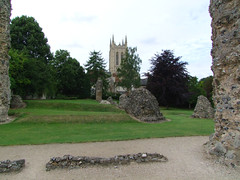 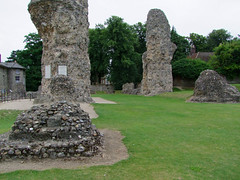
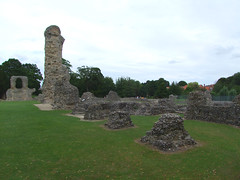 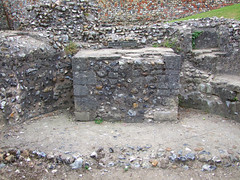 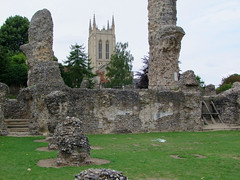
We have a record of the last years
of the Abbey in the work of John Lydgate, who
came from the Suffolk village of Lidgate. He
records that the Abbey gave a quarter of its
income in relief to the poor of the Liberty, and
distributed food and alms at its gates daily. The
guesthouses were open to all, even the poorest of
pilgrims; St Edmund's Abbey was no longer a
centre for the wealthy.
In 1538, the monasteries were dissolved, their
possessions were sold off, and the monks all
given pensions. Senior monks that protested too
loudly were put to death. The money from the sale
of goods accrued to the crown, and the land also.
One intriguing question is what happened to the
body of Edmund at the Dissolution. Many Saints'
bones were desecrated and publicly exhibited,
paraded in the street before being burned, or
fashioned into clumsy weapons, musical
instruments or hockey sticks, in a grisly attempt
to demonstrate that they held no spiritual power.
The less ideologically-driven reformers were
conspiring to sell the relics abroad, reasoning
that the money European churches were willing to
pay for them could legitimately be counted as the
wealth of the church that was to accrue to the
state. So, were the bones of St Edmund sold or
desecrated? At the Dissolution, the commissioners
write of the huge size of the tomb, that it
was<i> comberous to deface</i>, and
mention the loot sequestered from the Abbey
itself, but there is no mention of the corpse of
St Edmund, and nothing to reveal its whereabouts.
In an elegant and fascinating essay entitled St
Edmund's Corpse: Defeat into Victory, the
late Suffolk historian Norman Scarfe recorded the
presence of a skeleton in the Cathedral of St
Sernin, Toulouse, labelled Corpus S Eadmundi
Regis Anglie ('The body of Saint Edmund,
King of the English'). This corpse was in the
cathedral certainly as early as 1270, and the
story that was current by the late 16th century
was that it had been stolen from the shrine at
Bury in the year 1216, during the anarchy of the
Barons' War.
Whoever this body was, it was offered back to the
English Church in 1901, at the time of the
consecration of Westminster Cathedral. Cardinal
Vaughan, the leader of the English Church at the
time, readily accepted the offer of renewing the
shrine in his new Cathedral, and the corpse was
brought by train to Dieppe, and thence to
Newhaven in Sussex, where it was kept in the
chapel of the Duke of Norfolk's house at Arundel,
until the new shrine was ready.
At this point, things started to go awry. A
correspondence in the press revealed the
considerable doubts of historians and theologians
that the corpse could possibly be that of St
Edmund. The Cardinal lost his nerve, and the
corpse was never translated to Westminster. And
so, at Arundel it remains, a century on. It could
be Edmund, I suppose. More likely, perhaps, the
bones were buried quietly at night by members of
the chapter, when it became clear what the
writing on the wall was saying. In which case,
they lie beneath the soil of Bury to this very
day.
After the Reformation, some great English Abbey
churches became cathedrals, but that did not
happen here. And yet, it so easily might have
done. Way back in 1070, some 500 years
previously, Herfast, Bishop of East Anglia,
decided to move his See from Thetford to Bury. It
had moved about a bit already over the previous
400 years, from Walton to North Elmham before
Thetford. But now, after the Norman Conquest, the
idea was that Cathedrals would be glorified;
already, vast edifices were being raised in
Durham, London and Ely. Bury was the obvious
place for the Diocese of East Anglia to sit.
However, such a move would have cut off the
Abbey's independent direct line with Rome, and
placed it under the jurisdiction of the Province
of Canterbury. The community was determined that
this would not happen, and Abbot Baldwin sent
representations to the Pope that ensured the
survival of the Abbey's independence.
Bishop Herfast would not be allowed to glorify
his position in East Anglia in the way his
colleagues were doing elsewhere. His successor,
Herbert de Losinga, was more determined. But Bury
was a lost cause; instead, he chose to move his
See to a thriving market town in the north east
of his Diocese; a smaller, more remote place than
Bury, to be sure; but proximity to the Abbey of
St Edmund was perhaps not such a good thing
anyway - it tended to cast a rather heavy shadow.
And so it was that the great medieval cathedral
of the East Anglian bishops came to be built,
instead, at Norwich.
Five hundred years later, the Dioceses of Norwich
and Ely, into which Suffolk evenly fell, were not
large; and, in any case, they were loyal to the
crown. The same could not be said of the Abbey,
where the community was still fiercely
independent of the State; as at Walsingham, of
course, where the Abbey church was destroyed even
more effectively.
For two centuries after the dissolution, the
Abbey effectively became a quarry for the people
of Bury, who carted off its stone for other
buildings. By the end of the 17th century, what
had happened here had been virtually forgotten.
The Protestant Cultural Revolution in England was
at its height. It wiped the people's collective
memory of their Catholic past. History was at
least resurfaced, if not selectively rewritten.
But the enlightenment of the 18th century saw a
rekindled passion for history, especially among
those with the leisure to pursue it. How
fascinating and remote these ruins must have
seemed by then! What stories the ordinary people
must have told about them!
With the 19th century revival came a new respect
for the medieval past, but it was not until the
1950s that these ruins were properly opened up to
the people of Suffolk, their true inheritance.
| My son, unlike me, was born
in Suffolk. I had him with me when I
visited on that September day in 2000. he
was seven. As with all children, he took
the ruins at face value. His mind can't
possibly reconstruct what was here
before. Instead, he invented universes,
oceans of possibility and imagination, as
far from the world today as that which
Abbot Sampson inhabited. He clambered on
the ruins with other children, the north
wall of the transept becoming a sea
cliff, the steps into the crypt a
Himalayan mountain path. As far as he was
concerned, anything might have happened
here. And that's what
archaeology mostly is, I suppose; it's
about narrowing down the possibilities.
It is about finding the cord that leads
all the way back.
People wander aimlessly about these ruins
- you'll never be alone here. Is this the
same spiritual thirst that sends them
into medieval churches? When they aren't
locked, that is.
Or is it something more
primal, some human need to open up a
perspective on where we have come from;
and thus, who we are. The Church of
Felix, Fursey, Botolph and Edmund has
undergone many changes in the 1300 years
or so since their adventures were played
out on the fields of Suffolk. Most
recently, at the Second Vatican Council,
it taught us about the Journey of Faith,
that life is a pilgrimage towards God.
And, of course, we've already come a long
way.
|
|
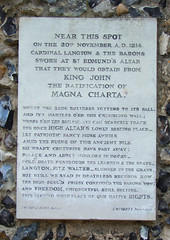 |
Simon Knott, September 2000,
revised and updated August 2015
 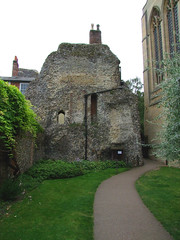 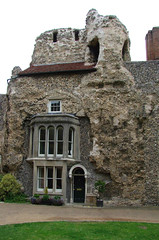 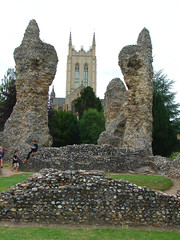
|
|
|

